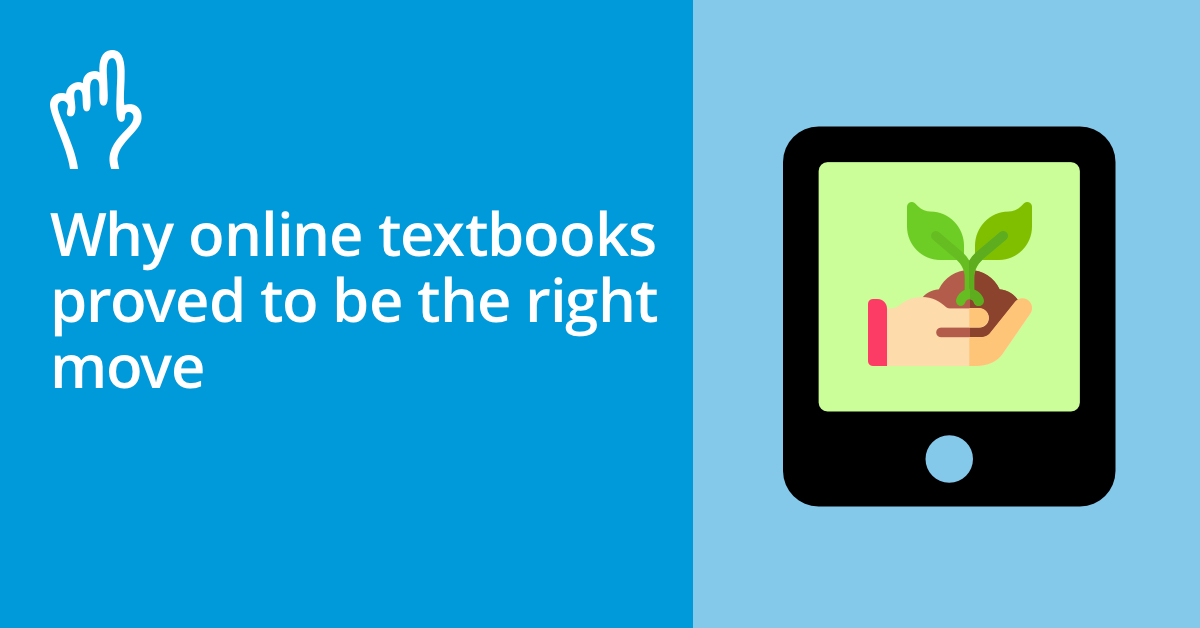Here are 10 hidden costs of physical textbooks. Before we start, how many can you guess? (Don’t skip the last one. It might surprise you.)
- Water costs and the environmental impact of the production of paper
You know that books come from trees and that those trees play an important role in maintaining air quality and the balance of surrounding ecosystems. Water – or rather, clean water – is also an integral part of the paper-making process. And making pulp and bleaching paper to create quality, “whiter than white” paper for printing books is thirsty work. Some countries use as much as 10% of their water to make pulp and paper, and clean water comes at a cost. Let’s not forget that less than 1% of the world’s water is fresh and available for us to consume. Its processing has a sizeable environmental impact.
For more on “What makes producing paper such a thirsty business?” read:
Paper Making: What makes Paper Production such a wasteful process? – Paper / on the Rocks (paperontherocks.com)
- Transport costs
This doesn’t need spelling out. The need for road, rail, or air travel for its transportation also has a financial and environmental cost. And if you’ve moved house and had to lift boxes of books, you’ll know they’re HEAVY.
- Time spent distributing books within schools
Once they get to schools, textbooks don’t magically arrive in the right classroom or department. Here’s the rub – they don’t always arrive correctly labelled, either. If only!
From secretaries and caretakers to heads of department and head teachers, everyone has a hand in allocating heavy parcels of books, many of which may have arrived with only the school’s address.
And it’s not always obvious who has ordered what. Cue a flurry of “Has anyone ordered…?” emails round the school, which then goes on to waste everyone else’s time.
The English department may well have ordered those copies of The Boy in Striped Pyjamas. Or it could have been the RS department, or perhaps history is teaching the Holocaust, or… You get the picture.
And when it, finally, gets to the right teacher or classroom, it then has to be allocated to pupils, with the consequent loss of learning time. (And we’ve not even mentioned labelling, stamping, plastic covers, spreadsheets, and more.)
“The ease and speed with which the books are available mean no time wasted photocopying pages or frustration at students forgetting to bring books in from home!”
Anna Dickson*
- Storage for teachers and pupils
Where to store all that paper when space is at a premium in many schools? Storage rooms and cupboards are needed for other things. And you can’t just dump textbooks anywhere. They need to be stored safely and they are sensitive to the elements, such as dust, humidity, and dampness.
Furthermore, student lockers are expensive and prone to getting damaged, with resulting repair costs. (You don’t need us to tell you that digital files and folders don’t take up physical school space.)
- Hours lost to stock keeping every year
After marking, the yearly or even termly stock take must rank among teachers’ least favourite things to do. And it’s never straightforward. Consider, for instance, the issue that books purchased at different times might be different editions.
- Time spent collecting books
Pupils forget to take physical textbooks home and they forget to bring them back. It’s a young person thing, something to be expected and forgiven. The problem lies in repeated forgetfulness when you need to collect in and reallocate key textbooks. This often results in the loss of vital teaching time, both for those needing the textbooks and those being asked, repeatedly, to pass them on.
- Time spent chasing, emailing, phoning home
Repeated “polite” requests for returns sometimes fall on deaf ears. Plan B means communicating with parents. This can take hours of time teachers simply don’t have.
- Time and cost of charging for and chasing payment for lost / damaged books
Textbooks get lost or damaged. It’s all part of life. But processing this can get complicated and takes time.
“It can save wear and tear on the textbooks if the pupils don’t have to carry them in and out of school. They can access their online book at home and use the hard copy in school so the life of the textbook is lengthened.”
Joan McClintock *
- Damage or loss within schools
Remember Dudley, Eunice, and Franklin, which ripped across the country in February 2022. Three storms over just a few days is highly unusual in the UK. Schools were forced to close due to heavy rain, snow, and 100 mile-per-hour winds. One school suffered over £40,000 of damage after the storms destroyed its roof, flooding two classrooms. While the cost of most repairs is usually covered by insurance, it was not clearcut whether classroom displays, décor, or books would be. Many schools resorted to fundraising.
“We have saved money by using digital textbooks which students can access at any time. They can’t be damaged or lost.”
Clare Caple*
- Disposal costs of paper books
And not skipping the last one, there is also wear and tear, and the process of time. Churn or attrition is to be expected. Like storms, it’s no one’s fault. Furthermore, syllabuses change, or schools change specifications. And all textbooks have a shelf life. (Digital textbooks, of course, are more easily updated.)
Old textbooks can’t simply be dumped in recycling, with the rest of paper. The glue, string, and other binding materials complicate the recycling process. Hardbacks are especially problematic.
Schools often hire skips, which proves costly and takes up valuable space, as well as being a health and safety risk.
It’s a sad fact that many textbooks simply end up in landfill. A 2012 National Wildlife Federation-sponsored report by Laura S. Hickey and Kristy Jones estimated that at least 640,000 tons of books are sent to the landfill on a year-to-year basis.
A more recent study in the US estimated that a staggering 320 million books ends up in landfill every year, with only 33.3% of books being saved from this fate, according to Environmental Protection Agency (EPA).
There is the option of donating old textbooks to charities, if they are in good condition, but this again entails transportation costs for someone. As we said at the beginning, textbooks are HEAVY.
Final thoughts
So, there we have it: 10 hidden costs of physical textbooks, or 10 headaches head teachers, heads of department, the finance office, support staff, and the school in general can live without.
Did you guess them all?
Did WE miss any?
Let us know at infoUk@classoos.com
*Classoos reviews on EdTech Impact





